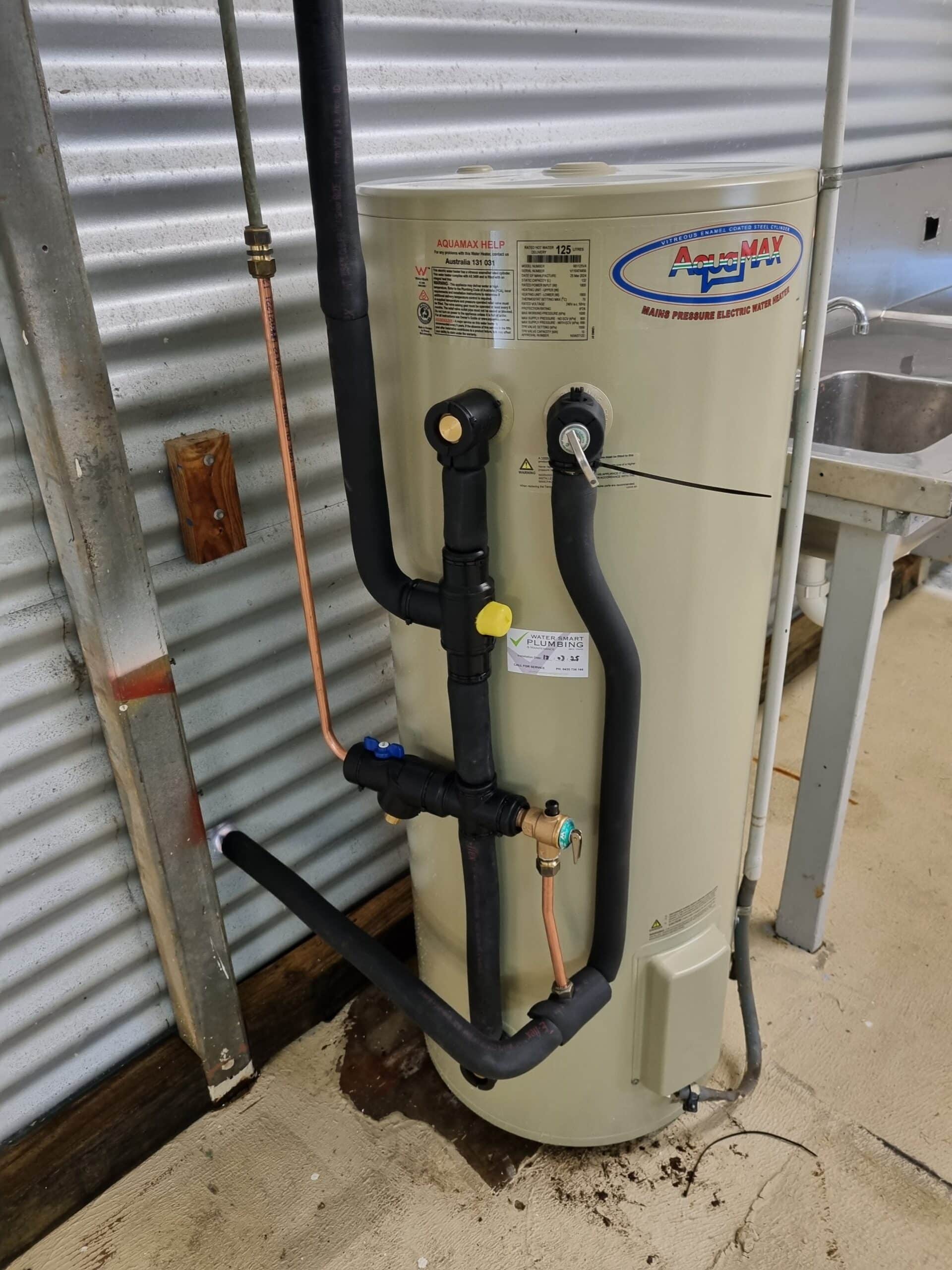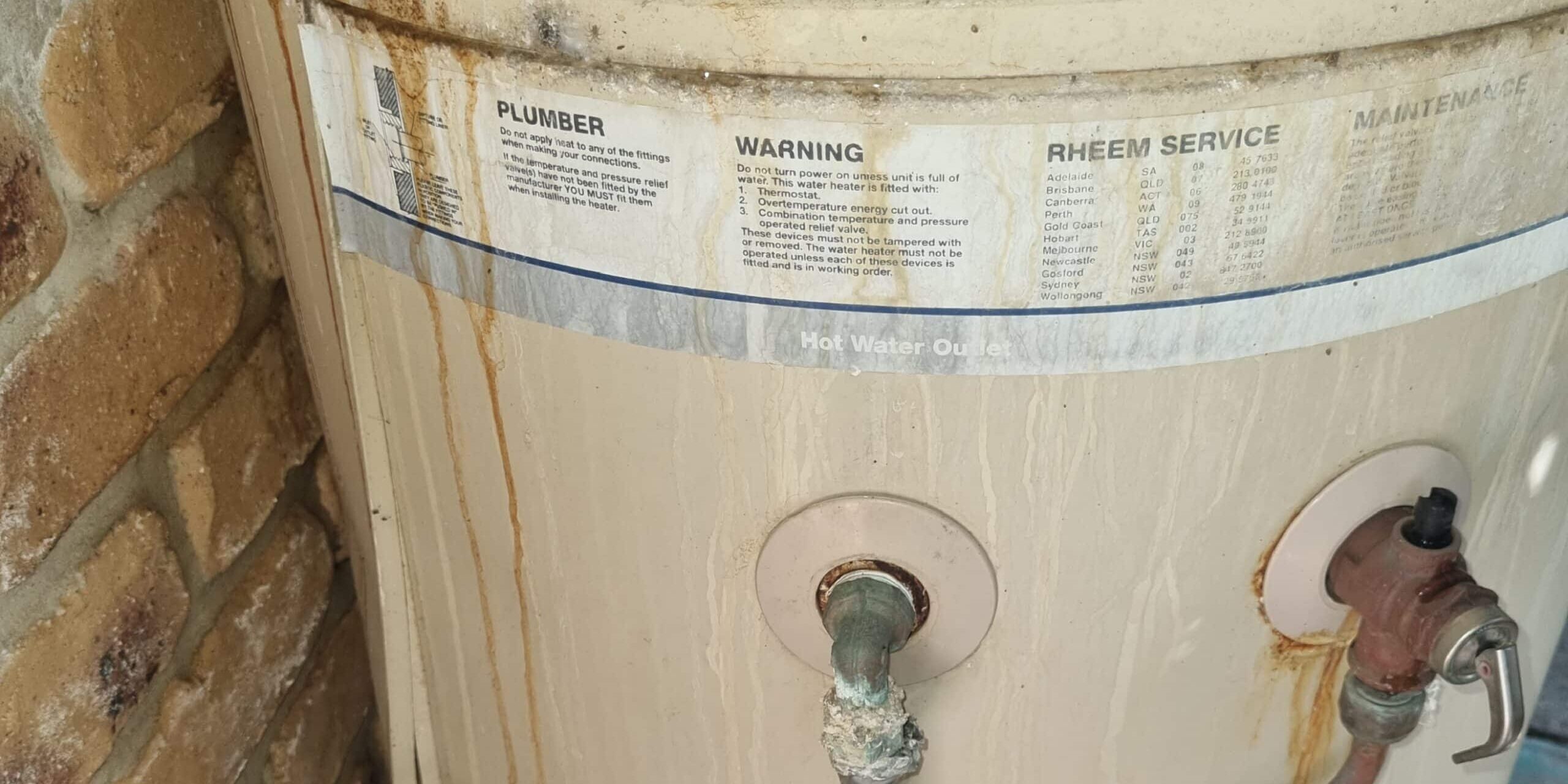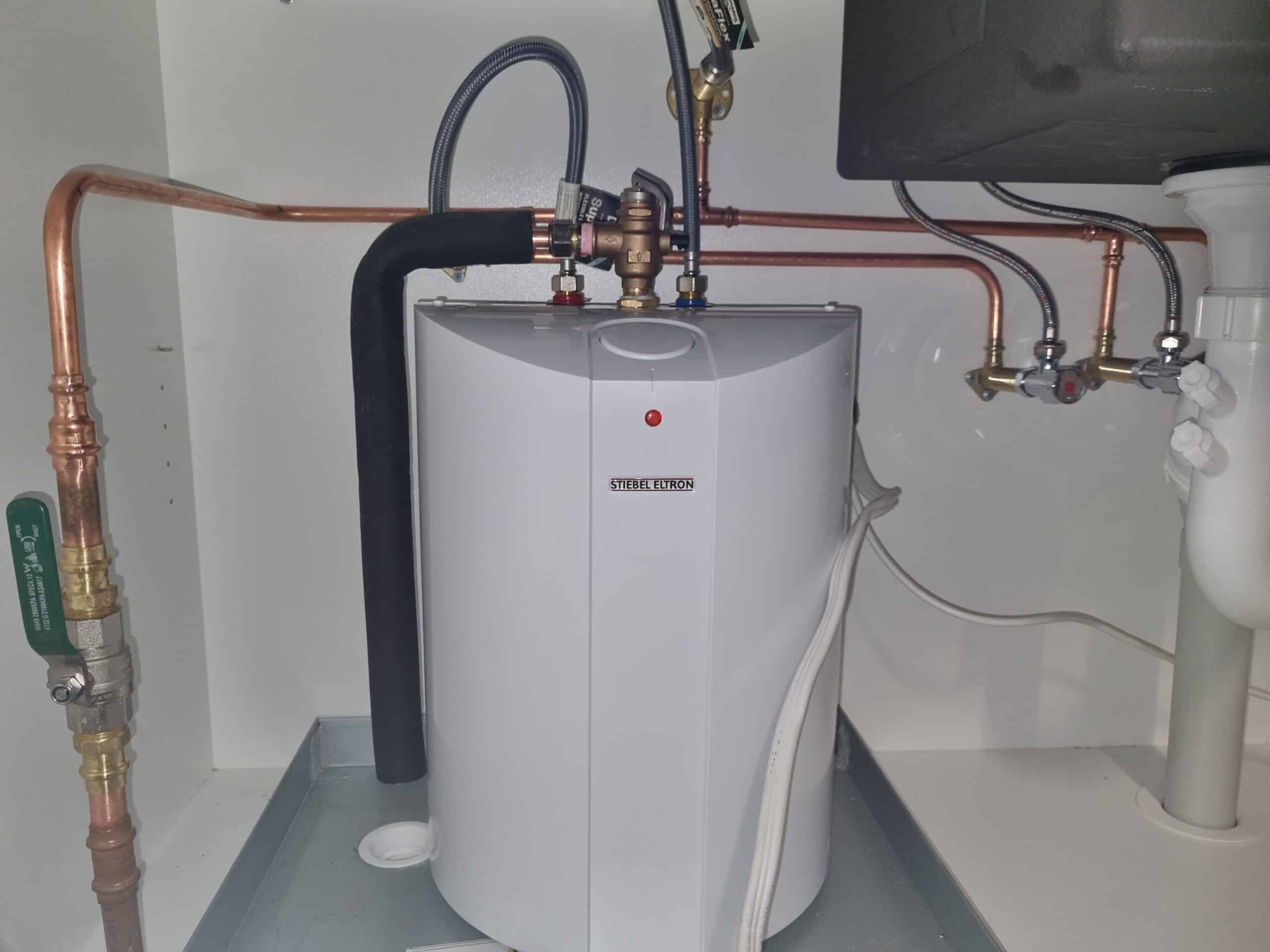Have you noticed water pooling around your hot water system? A leaking hot water system isn’t just a minor household hiccup; it can wreak havoc on your floors, walls, and furniture if you don’t act quickly.
Hot water system leaks can happen for different reasons. Faulty pressure relief valves, damaged tanks, and loose pipe fittings are the usual suspects. The real question is: Why is your specific system leaking water? The answer typically comes down to two things: how old your unit is and how well it’s been maintained. Most hot water systems will serve you well for 10-20 years with proper care, but once they hit the 8-year mark, they’re far more likely to develop leaks that mean you’ll need a complete replacement.
This guide will walk you through the warning signs of a leaking hot water system, show you how to pinpoint exactly where the leak is coming from, and give you the immediate steps to take when you spot a problem. We’ll also help you decide whether a repair will do the job or if replacement is your smartest move. Armed with the right knowledge, you’ll be ready to tackle this potentially expensive household emergency head-on.
Common Signs Your Hot Water System Is Leaking
Spotting a hot water system leak early can save you thousands in repairs and prevent serious property damage. Some leaks are obvious, but others lurk behind the scenes until they’ve caused major problems. Here are the key warning signs that your hot water system is leaking.
1. Water is pooling around the unit
The telltale sign: Unexplained moisture or puddles around your hot water system.
Water pooling beneath or next to your unit is a dead giveaway that water is escaping somewhere in the system. Don’t ignore dampness or water stains around the hot water tank either—they signal potential structural damage that’s building up over time. A small amount of water dripping from the valves might be normal, but a constant stream or large puddles need immediate attention.
3. Drop in water pressure or temperature
Notice your shower pressure isn’t what it used to be? A noticeable drop in water pressure across your taps and appliances often points to a hot water system leak. The same goes for inconsistent hot water temperatures—your system might be losing water somewhere. This happens because escaping water messes with the heater’s ability to maintain steady temperatures. The leak throws off the pressure balance in your system, making your hot water supply less effective.
3. Unusual sounds or smells
Hear running water when no taps are on? That’s a strong sign you’ve got a leak somewhere in your system. Loud popping sounds from your water heater tank are another red flag—they could signal potential problems, possibly even an imminent tank rupture. Keep your nose alert too. A rotten egg smell near your water heater is another warning sign of system failure that could be leak-related.
4. Higher-than-normal water bills
Your water bill is shooting up for no apparent reason? This is often the first warning sign of a hot water system leak. An unexpected jump in water consumption that you can’t explain with extra household members or changed usage patterns usually means you’ve got a hidden leak. Leaks are actually the most common cause of unusually high water bills. Even a small, ongoing leak can waste huge amounts of water over time, bumping you into a higher pricing tier and seriously inflating your costs.
Important note: Some leaks stay hidden until they become serious problems. Regular checks of your hot water system are essential for catching issues before they turn into major repairs or replacements.
Where Is The Leak Coming From?
Once you’ve spotted the signs, finding the exact source of your hot water leak becomes your next priority. Effective repairs depend on knowing precisely where the water is escaping from.
1. Leaking from the top of the tank
Top-of-tank leaks usually point to your sacrificial anode as the main suspect. This component deliberately corrodes over time to protect your tank from rust. When the anode has done its job and corroded significantly, it can no longer shield your tank effectively, and leaks start appearing around its connection point.
Cold water inlet and hot water outlet connections also loosen with age and use. Check these areas for any signs of corrosion or moisture buildup.
2. Leaking from the bottom of the tank
Bottom leaks spell more serious trouble. Sediment builds up at the base of your tank over the years of use, causing rust that eventually eats through the metal. The tank’s structural integrity becomes compromised from the inside out.
Your drain valve might also be the culprit—it could be loose, damaged, or simply not closing properly. A functioning drain valve should stay completely shut when you’re not using it.
3. Dripping from the pressure relief valve
The pressure relief valve (also known as the temperature and pressure relief valve or TPR valve) acts as your system’s safety mechanism. It releases water when internal pressure gets too high.
Some dripping during heating cycles is perfectly normal. Constant dripping or streaming, however, signals trouble. High water pressure, faulty valve parts, or a thermostat that’s causing overheating could all be behind the problem.
4. Leaks from pipes or fittings
Pipe connections naturally loosen over time. Australia’s harsh weather conditions, temperature fluctuations, and general wear all take their toll. These connections expand and contract regularly with temperature changes, which gradually deteriorate the seals.
Look for water trailing along hoses or dampness around any connection points.
5. Solar panel or mixing valve issues
Solar hot water systems have their own leak-prone spots. The frost protection valve commonly fails after enduring several winters. Check for damaged seals, cracked pipes, or problems with the solar collector itself.
Thermostatic mixing valves (TMVs) can develop leaks when their seals fail or corrosion sets in.
6. Condensation vs actual leak
Don’t mistake condensation for a leak. Cold water entering your tank creates moisture on the outside surface, especially during humid conditions—a common occurrence across much of Australia.
Here’s a simple test: wipe the area completely dry and watch what happens. Water reappearing quickly means you’ve got a genuine leak. If the area stays dry, you were probably just seeing condensation.
What To Do When You Notice A Leak
Quick action when you spot a hot water system leak can mean the difference between a minor repair and major property damage. The steps you take in those first few minutes will determine how much this problem costs you.
1. Turn off the water supply
Your first priority is stopping more water from entering the system. Look for a small black tap or round dial on the pipe leading into the bottom of your hot water system—turn this clockwise until it’s fully closed. Can’t locate this valve or find that it’s completely seized? You’ll need to shut off the water at your property’s main meter, usually positioned at the front or side of your house.
2. Switch off the power or gas
Safety comes next. For electric systems, head to your home’s main electrical panel and switch off the circuit breaker labelled for your hot water heater. Gas systems require a different approach—turn the thermostat dial from “ON” to “OFF” and shut the gas supply valve by turning it clockwise until it stops moving.
3. Check if the leak is minor or serious
Now assess what you’re dealing with. Small drips from valves might point to minor issues that a quick fix could handle. Water pooling around the unit? That’s a more serious problem. Even tiny leaks can signal internal tank corrosion, so don’t dismiss them as harmless.
4. Avoid DIY fixes for major issues
Hot water systems bring together heat, electricity, and pressure—not exactly a beginner-friendly combination. Attempting repairs without the right knowledge often makes problems worse, voids warranties, or creates genuine safety hazards. Leave complex issues involving electrical components or pressurised systems to the professionals.
5. Call a licenced plumber
Get a qualified plumber to properly diagnose and fix the issue. Licensed plumbers ensure repairs meet safety standards and Australian regulations while quickly determining whether a simple repair will do the job or if your system needs replacement. This saves you time and prevents the problem from escalating into something far more expensive.

Repair Or Replace? Making The Right Call
The big question you’ll face is: should you fix your leaking system or bite the bullet and replace it entirely? Making the wrong choice here can cost you hundreds, or even thousands, of dollars down the track.
1. When a simple repair is enough
Simple fixes make sense for newer systems. Problems like a broken heating element, a faulty thermostat, or a tripped circuit breaker are usually straightforward to resolve. These repairs can typically be sorted quickly and won’t break the bank.
Bonus tip: If your system is still under warranty, you might get some repair costs covered, which makes the repair option even more attractive.
2. Signs your system needs replacing
Here’s when replacement becomes the smarter financial move:
- Frequent breakdowns requiring multiple repairs each year
- Visible rust or corrosion on the tank itself
- Discoloured water coming from your taps
- Unusual noises like rumbling or banging that suggest serious sediment buildup
These issues typically signal internal problems that are beyond economical repair.
3. How age and condition affect the decision
Age is the deciding factor in most cases. Most hot water systems last 10-15 years with proper maintenance.
For systems under 10 years with isolated problems, repairs usually make more sense. But once your system crosses that age threshold, even well-maintained units become less efficient and more failure-prone. That’s when replacement often delivers better long-term value.
4. What to expect from a replacement process
The replacement process starts with assessing your household’s specific hot water needs. For help determining whether to repair or replace your leaking hot water system, contact Water Smart Plumbing for professional plumbing services and personalised advice tailored to your situation.
Installation typically causes temporary downtime, usually a few hours to a full day, depending on complexity. The key is choosing the right replacement system based on your household size, usage patterns, and energy efficiency goals to ensure reliable hot water for years ahead.
Conclusion
Hot water system leaks aren’t something you can ignore and hope they’ll fix themselves. This guide has walked you through everything you need to know—from spotting the early warning signs to pinpointing leak sources, taking immediate action, and making smart repair versus replacement decisions.
The key takeaway? Act fast when you spot a leak. Quick action prevents extensive water damage and keeps repair costs from spiralling out of control.
Knowing where your leak is coming from makes all the difference in choosing the right solution. While minor issues might only need simple fixes, older systems often make more financial sense to replace entirely. Your system’s age and overall condition will guide this decision.
Safety comes first when dealing with hot water system leaks. Turn off water and power immediately, then get professional help. For all your hot water system needs, reach out to Water Smart Plumbing for professional hot water plumbing services in Buderim and surrounds. With us, you can expect expert advice and guidance to ensure your system operates safely and efficiently.
Regular maintenance checks help catch problems before they become expensive disasters. Whether you’re looking at repair or replacement, addressing leaks quickly saves money, protects your property, and keeps your household running smoothly with reliable hot water.








